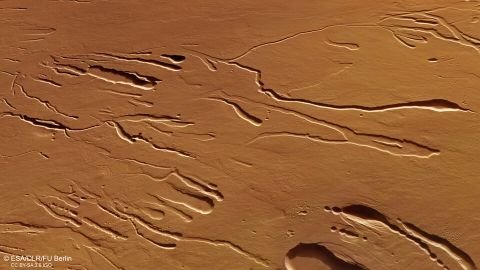Some of the Solar System’s most stunning volcanoes are found on Mars. The second-tallest mountain on the planet, Ascraeus Mons, has now been observed by ESA’s Mars Express. The High-Resolution Stereo Camera (HRSC) on Mars Express provided the data for this image.
How was Ascraeus Mons observed and what data was used?
Three major volcanoes may be found in the Tharsis region of Mars, a volcanic plateau in its western hemisphere, with Ascraeus Mons being the northernmost and tallest of them all. Despite its enormous height of 18 km, it has mild slopes, with an average inclination of 7 degrees. The volcano’s enormous base diameter of 480 km, which gives it a footprint on Earth almost the size of Romania, reflects its gradual ascent.

Just Olympus Mons, the tallest volcano not just on Mars but also in the entire Solar System, is taller than Ascraeus Mons.
What is Ascraeus Mons and where is it located?
The photograph depicts Ascraeus Mons’ lower southern flank. The left (southern) and right (northern) sides of the frame are dramatically different in height, with the left side of the frame being about 10 kilometers lower. The larger background map of the area shows the volcano’s peak to be to the right of the frame or north.
Collective name for these features in the photograph – “Ascraeus Chasmata”:
Broad the frame, several similarly stunning phenomena can be seen, including lava flows and tubes, chains of craters, channel-like rilles, and massive fissures extending tens of kilometers in length. These features collectively are known as Ascraeus Chasmata and comprise an extensive piece of collapsed terrain over 70 km broad.
These features, which are all of various ages and origins, come together to create a scene that resembles ink trails dispersing gracefully in water or a plant’s exquisitely intricate root system as it burrows into the ground.
What are pit craters and how do they form?
Multiple wrinkly lava flows are visible on the right side of the frame. Then, on top of this uneven terrain, are chains of “pit craters”—formations made of a series of round or nearly circular depressions that have come together to form troughs. We also observe these on Earth, with the striking Cenotes on Mexico’s Yucatán Peninsula serving as a famous example. The pit crater chains and troughs shown here have also gathered to create a very sizable and striking collapse area.

Subsurface Void Formation:
These chains and troughs most likely appear where subsurface cavities that are not visible to the naked eye cause the ground to become unstable and collapse, rather like a sinkhole. The lava flow beneath is then considered to have stopped and ebbed away over time, leaving tube-shaped pockets of space lurking several meters below the surface. This is how the subsurface voids are thought to have formed.
What are sinuous rilles, and where are they typically found on Mars?
So-called “sinuous rilles,” which are typically found near the sides of volcanoes and are smaller, twisting channels without rims, are seen on the ground to the left of the pit crater chains. Although the exact process of how these come into being is yet unknown, it may entail flows of lava, ash, water, or a combination of the three.
Mars’ Braided Channels:
Large fractures up to 40 km long dominate the leftmost portion of the photograph. The ‘braided channels’ that branch out from these fractures isolate sections of the Martian landscape to create ‘islands’ and terraces by weaving and braiding together. These were probably produced by water, perhaps as snow and ice accumulated on Ascraeus Mons’ flanks before melting away.
How does Mars Express investigate the makeup and circulation of Mars’ atmosphere?
Since its launch in 2003, Mars Express has been orbiting the Red Planet, taking pictures of its surface, charting its minerals, determining the makeup and circulation of its flimsy atmosphere, penetrating beneath its crust, and investigating how various phenomena interact on Mars.
What did we learn from the study of Ascraeus Mons?
With photographs revealing everything from wind-sculpted ridges and grooves to impact craters, tectonic faults, river channels, and ancient lava lakes, the orbiter’s HRSC, which is responsible for these new images, has revealed much about Mars’ various surface features. Ascraeus Mons is a wonderful example of the enormous volcanoes on the Red Planet that are visible in many Mars Express photographs.





